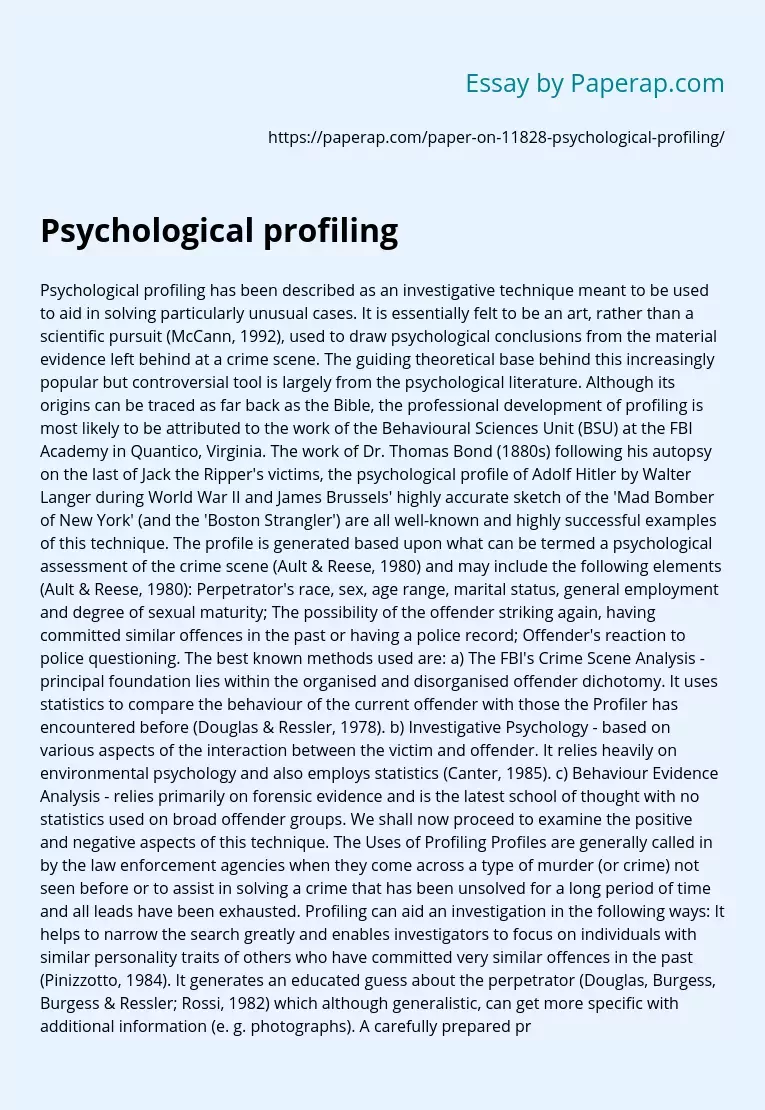Psychological profiling As an Investigative Method
It is essentially felt to be an art, rather than a scientific pursuit (McCann, 1992), used to draw psychological conclusions from the material evidence left behind at a crime scene. The guiding theoretical base behind this increasingly popular but controversial tool is largely from the psychological literature.
Although its origins can be traced as far back as the Bible, the professional development of profiling is most likely to be attributed to the work of the Behavioural Sciences Unit (BSU) at the FBI Academy in Quantico, Virginia.
The work of Dr. Thomas Bond (1880s) following his autopsy on the last of Jack the Ripper’s victims, the psychological profile of Adolf Hitler by Walter Langer during World War II and James Brussels’ highly accurate sketch of the ‘Mad Bomber of New York’ (and the ‘Boston Strangler’) are all well-known and highly successful examples of this technique.
The profile is generated based upon what can be termed a psychological assessment of the crime scene (Ault & Reese, 1980) and may include the following elements (Ault & Reese, 1980): Perpetrator’s race, sex, age range, marital status, general employment and degree of sexual maturity; The possibility of the offender striking again, having committed similar offences in the past or having a police record; Offender’s reaction to police questioning.
The best known methods used are: a) The FBI’s Crime Scene Analysis – principal foundation lies within the organised and disorganised offender dichotomy.
It uses statistics to compare the behaviour of the current offender with those the Profiler has encountered before (Douglas & Ressler, 1978).
b) Investigative Psychology – based on various aspects of the interaction between the victim and offender. It relies heavily on environmental psychology and also employs statistics (Canter, 1985). c) Behaviour Evidence Analysis – relies primarily on forensic evidence and is the latest school of thought with no statistics used on broad offender groups. We shall now proceed to examine the positive and negative aspects of this technique.
The Uses of Profiling Profiles are generally called in by the law enforcement agencies when they come across a type of murder (or crime) not seen before or to assist in solving a crime that has been unsolved for a long period of time and all leads have been exhausted. Profiling can aid an investigation in the following ways: It helps to narrow the search greatly and enables investigators to focus on individuals with similar personality traits of others who have committed very similar offences in the past (Pinizzotto, 1984).
It generates an educated guess about the perpetrator (Douglas, Burgess, Burgess & Ressler; Rossi, 1982) which although generalistic, can get more specific with additional information (e. g. photographs). A carefully prepared profile may also be able to help connect past unsolved crimes to the current offender (an aid to linkage blindness). Examine a series of cases to see if there is a link between two or more cases based on the crime scene and the victims (recognition of what is referred to as a “signature”)
Some indication could be provided as to whether or not future attacks are likely which could help in lowering the number of victims. Valuable tips could be obtained about possible items to add to a search warrant, e. g. souvenirs, pornography, photos. Along with possibly enabling quicker apprehension of the offender, a profile could suggest possible interrogation strategies for the police to elicit information from the suspect. Profilers could also serve as an expert witness and help jurors to understand the dynamics and motivations of the killer.
The FBI’s attempt to test inter-ratal reliability using six of its agents provided with basic details of 64 murder scenes was followed by comparing these results (for type and structure of each crime scene) with existing profiles. This revealed a high inter-rater reliability for classification of type of crime (84%) but a lower result for structure of the crime (74%). Some feel that its grounding in sound testable psychological theory ensures its validity (Grant).
The FBI’s cost-benefit study in 1981 to assess the utility of profiling found that of 192 profiled cases, only 46% were solved and only 17% of suspects were identified directly by the profile. However, in 77% of cases profiling helped to properly focus the investigation, in 20% it helped to locate possible suspects and in 6% aided in successful prosecution with only 17% of solved cases considering profiling to be of little or no assistance (Pinizzotto, 1984).
Study using a closed case method (known offender) compared profiles, detectives and college students on the quality of profiles found that although profiles differed little from detectives in processing the evidence, they were more accurate in answering specific questions about sex related offences. Several researchers have also provided preliminary support for the central premises of ‘signature’ and ‘organised/disorganised’ typology that profiling relies on (Ressler et al, 1988; Canter & Heritage, 1990; Gratzer & Bradford, 1995; Dietz, Hazelwood & Warren, 1990).
Using the statistical technique of ‘Smallest Space Analysis’, strong support was obtained for the use of ‘signature’ in profiling (Canter & Heritage, 1990). Crime Scene Analysis (FBI) is a well known and widely accepted method that has resulted in a number of profiles with some research support of its tenets (see above). Investigative Psychology with its geospatial principles has been extremely useful too in profiling homicide and sexual assaults. Behaviour Evidence Analysis has been acclaimed for its good cross-cultural applicability and robust foundation based on forensic evidence.
Psychological profiling As an Investigative Method. (2018, Jan 01). Retrieved from https://paperap.com/paper-on-11828-psychological-profiling/

